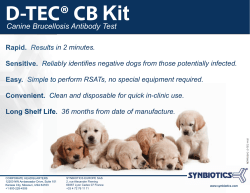
P A T H
PATHWAY OF CARE FOR THE DIAGNOSIS AND MANAGEMENT OF ACUTE BRUCELLOSIS IN PRIMARY CARE Prepared on behalf of the Brucella Subgroup of the Northern Ireland Regional Zoonoses Group August 2004 1 PATHWAY OF CARE FOR THE DIAGNOSIS AND MANAGEMENT OF ACUTE BRUCELLOSIS IN PRIMARY CARE 1. Purpose and Target This care pathway aims to describe best practice in the approach to the early detection, management and follow up of human brucellosis caused by Brucella abortus. This guidance is intended primarily for General Practitioners. It is not intended to cover the clinical management of complications of the disease. It has been developed by a multidisciplinary professional group using an evidence-based approach. 2. Clinical features of brucellosis An illness characterised by: Complications Include: acute or insidious onset Epididymo-orchitis continued, intermittent or irregular fever of variable duration profuse sweating particularly at night Osteoarticular disease: sacroiliitis fatigue, anorexia, weight loss Local supportive infection of organs such as the spleen Endocarditis headaches arthralgia and generalised aching 3. Diagnosis In the presence of symptoms, serology confirms the diagnosis. Serology is not recommended for disease screening. The management of a patient with a finding of positive serology in the absence of symptoms should be discussed with an infectious disease specialist or microbiologist. 4. Context Eighty-nine cases of human brucellosis have been reported in Northern Ireland in the period 1998-2003, following a 12-year period during which no cases were reported. This situation contrasts with that in the remainder of the UK (Table 1 and Figure 1). Table 1 Incidence of human brucellosis in United Kingdom Year 1999 2000 2001 2002 2003 England and Wales 9 6 6 7 5 Scotland 0 0 0 1 2 2 Northern Ireland 8 14 21 29 17 Of the small number of cases identified in England, Scotland and Wales, the overwhelming majority were due to B. melitensis, and were acquired outside the UK. Figure 1 Incidence of human brucellosis in United Kingdom 250 35 Number of Cases reported in Northern Ireland Number of cases in remainder of UK 30 Bovine herds with confirmed brucellosis (Northern Ireland) 150 20 15 100 10 Number of Positive Bovine Herds Number of Reported Cases 200 25 50 5 0 0 1999 2000 2001 2002 2003 Year The upsurge in numbers of human cases in Northern Ireland has occurred most likely as a direct consequence of the increased incidence of bovine brucellosis, which also commenced around 1998. Farmers living in the areas served by the Southern Health & Social Services Board (South Down, South Armagh and East Tyrone) comprise the majority of cases (Figure 2). Veterinarians, abattoir workers and other meat plant workers have also developed the disease. Prompt diagnosis and treatment, following the recommended antibiotic regimen, result in a cure in the overwhelming majority of cases. Figure 2 Geographical prevalence of human and bovine brucellosis 1999-2003 Herd Incidence (%) >6 b b b b bb b b 4-6 1-3 <1 b Human case b 10 56 b b b b b b bb 59 63 31 Greater Belfast 47 b b 61 b 21 b 58 bb b bbb b bb b 18 b bb b b b b bb b b b b b 25 39 30 b b b b b b b b bb b b bb 48 b bb b bb b b bb 24 b b b 3 40 b 33 5. Risk Factors/Risk Population Brucellosis is a zoonosis, which spreads from animals to people. In Northern Ireland, infected breeding cattle are the primary source of the disease. Human to human transmission is exceptionally rare and once treatment has been commenced the patient is no longer infectious. Transmission of Brucella abortus occurs through cuts or other breaks in the skin, through mucous membranes of the eyes, mouth and nose and through inhalation and ingestion. In an individual case, it is usually impossible to determine the likely route. Work activities related to calving or dealing with stillbirths present the greatest risk to people, as large number of organisms are present in the birth products and uterine and vaginal secretions of infected animals. The consumption of unpasteurised milk and cheeses also pose a considerable risk. The Northern Ireland Blood Transfusion Service has advised that certain restrictions apply to blood donation from individuals who have been identified as having brucellosis or been treated for it. Specific advice can be obtained from the Service directly by telephoning the medical helpline on 0500534669. 6. Post-exposure prophylaxis A decision on whether to prescribe antibiotics for post- exposure prophylaxis should only be made following in depth consideration of the individual circumstances and on the advice of a specialist clinician or microbiologist. CDC guidelines exist for circumstances where the risk of infection is high e.g. a needlestick injury from a needle contaminated with live brucella vaccine see: http://www.cdc.gov/ncidod/dbmd/diseaseinfo/brucellosis_g.htm 4 PATHWAY OF CARE FOR ACUTE BRUCELLOSIS IN HUMANS Clinical Diagnosis And/Or Occupational History suggest brucellosis Admission to hospital indicated? No Yes Arrange admissionLET HOSPITAL KNOW THAT BRUCELLOSIS IS SUSPECTED Investigations at first suspicion of brucellosis NOTE: ALL LABORATORY REQUEST FORMS MUST INDICATE IF BRUCELLOSIS IS CLINICALLY SUSPECTED Initial Investigation* for brucella serology: 5ml clotted blood FBP, U&E, CRP, ESR, renal and liver function tests Normally the microbiologist will contact the GP directly Symptomatic treatment until serology result available Serology positive? Yes No Give Patient Leaflet Exposure history and symptoms match case definition? -Due to risk of complications, URGENT outpatient referral of cases to Infectious Diseases Clinician at Royal Victoria Hospital, or specialist physician with expertise in brucellosis, is recommended -Inform CCDC Give Patient Leaflet Yes No Repeat initial investigation* Males, non-pregnant females and those 12 years and over -Rifampicin will discolour urine and tears orange/red -Soft contact lenses will also be discoloured and should not be worn -In females it will also interefere with the efficacy of the oral contraceptive pill Repeat serology in 2-4 weeks Pregnant women or children under 12 years of age Consider alternative diagnosis Seek specialist advice before commencing treatment -Start 6-week treatment course of combined antibiotics: Rifampicin: weight<55kg: 300mg bd TAKE ON EMPTY STOMACH PLUS weight >55kg: 450mg bd Doxycycline: 100mg bd TAKE WITH FOOD AND PLENTY OF FLUID Yes In women of reproductive capacity, ensure appropriate contraception, as doxycycline is teratogenic 5 Serology positive? No -Continue therapy for 6 weeks -Duration of treatment may need to be extended on specialist advice GP FACTSHEET: HUMAN INFECTION WITH BRUCELLA ABORTUS Background Animal and human infections with Brucella abortus were relatively common in Northern Ireland until control measures in cattle virtually eradicated the disease in the 1960s and 1970s. Prior to its re-emergence in 1998, there had not been a case of human brucellosis in Northern Ireland since 1985. Eighty-nine cases have been reported in the period 1998-2003, the majority of which have arisen in farmers in South Down, South Armagh and East Tyrone. Cases in veterinarians, abattoir workers and meat plant workers have also been reported. Complications Osteoarticular Reservoir Cattle are the main reservoir of Brucella abortus in Northern Ireland. Transmission from cattle to humans occurs – through breaks in the skin, by contact with tissues, blood, urine, vaginal discharges, aborted foetuses and especially placentas -by ingestion of unpasteurised milk/cheeses -airborne infection can occur in abattoirs and laboratories Transmission from human to human Human to human transmission is exceptionally rare. Once treatment has commenced there is no risk of human to human spread. Incubation period Highly variable and difficult to ascertain; usually 5-60 days, but 1-2 months commonplace. Cardiovascular Endocarditis is one of the most serious complications Gastrointestinal Symptoms commonly include anorexia, weight loss, nausea and vomiting and abdominal discomfort. The liver is not involved in the majority of cases. LFTs are usually only mildly abnormal but occasionally transaminases are elevated. Genitourinary Acute orchitis or epididymo-orchitis can be the presenting complaint; the testes are the most commonly involved organ of the genitourinary tract. Renal involvement is extremely rare. Neurological Depression and fatigue are common complaints of patients with brucellosis, but invasion of the central nervous system occurs in approximately < 2% of cases. Pregnancy and Children Diagnosis The infection is normally diagnosed by serology and must be interpreted carefully Bone and joint involvement is the most frequent complication, occurring in 20-60% of cases. A variety of syndromes have been reported including sacroilitis, arthritis of peripheral joints (predominantly involving the large joints) spondylitis, paraspinal and epidural abscess, osteomyelitis, tenosynovitis, bursitis/tendonitis and fibrositis The usual treatment regime is contraindicated in pregnancy and childhood. Specialist advice should be sought before commencing treatment in such cases. Prognosis: With adequate treatment, 85% of patients will have complete cure. Clinical A systemic bacterial disease with acute or insidious onset, characterised by continued, intermittent or irregular fever of variable duration; weight loss; profuse sweating; chills; headache; weakness; arthralgia; depression; and generalised aching. Localised supportive infections of organs, including the liver and spleen, may occur, and these may become chronic. Sub-clinical disease has been reported. Immunity: is not lifelong, and re-infection due to re-exposure can occur. Blood Donation: The Northern Ireland Blood Transfusion Service has advised that certain restrictions apply to blood donation from individuals who have been identified as having brucellosis or been treated for it. Specific advice can be obtained from the Service directly by telephoning the medical helpline on 0500534669. Hospital Referral Specialist opinion is necessary to detect the presence of complications at diagnosis, and to adjust the treatment regimen accordingly. Review enables advice on residual, non-specific symptoms to be provided. 6 Group Membership x Dr Delia Skan, Health and Safety Executive, Northern Ireland (HSENI) x Dr Sara Hedderwick, Royal Group of Hospitals Health and Social Services Trust x Dr Elizabeth Davies, Causeway Health and Social Services Trust x Dr Nizam Damani, Craigavon Area Hospital Group Trust x Dr Michael Devine, Northern Health and Social Services Board x Dr Vinod Tohani, Southern Health and Social Services Board x Dr Lorraine Doherty, Department of Health, Social Services and Public Safety for Northern Ireland x Dr Walter Boyd, Armagh and Dungannon Health Action Zone x Dr Brian Smyth, Health Protection Agency, Communicable Disease Surveillance Centre, Northern Ireland (CDSCNI) x Mr Rolly Harwood, Department of Agriculture and Rural Development for Northern Ireland (DARDNI) x Mr David Lowe, Health and Safety Executive, Northern Ireland (HSENI) x Dr Julie McCarroll, Health Protection Agency, Communicable Disease Surveillance Centre, Northern Ireland (CDSCNI) Acknowledgements x Dr Nick Beeching, Royal Liverpool University Hospital x Health and Safety Executive for Northern Ireland (HSENI) x Department of Health, Social Services and Public Safety for Northern Ireland (DHSSPSNI) x Health Protection Agency, Communicable Disease Surveillance Centre Northern Ireland (CDSCNI) x Department of Agriculture and Rural Development for Northern Ireland (DARDNI) 7 Health and Safety Executive for Northern Ireland 83 Ladas Drive BELFAST BT6 9FR Tel: 028 9024 3249 Fax: 028 9023 5383 Helpline: 0800 032 0 121 Text Phone: 028 9054 6896 Email: hseni@detini.gov.uk Web: www.hseni.gov.uk 8
© Copyright 2025



















